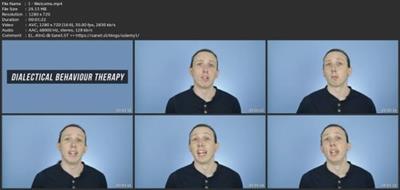
Dialectical Behaviour Therapy (Dbt)
Last updated 6/2022
MP4 | Video: h264, 1280x720 | Audio: AAC, 44.1 KHz
Language: English | Size: 2.85 GB | Duration: 3h 13m
Become a DBT practitioner and help people manage their mentions and improve their mental health[/center]
What you'll learn
Dialectical Behaviour Therapy (DBT)
DBT is a form of cognitive behavioural therapy that uses mindfulness
Managing difficult and intense emotions
Conducting skills training
Delivering DBT step-by-step
Use DBT to improve people's mental health
Requirements
There are no perquisites as all DBT concepts will be explained from their foundations
Prior knowledge of cognitive behavioural therapy, mindfulness and person-centred counselling will aid understanding but is not required
DBT can be more technical than other psychotherapies, so students are encouraged to make notes and participate in exercises
Description
Dialectical Behaviour Therapy (DBT) is a type of cognitive behavioural therapy (CBT) that uses mindfulness-based techniques to help people manage difficult emotions.It was originally developed to treat borderline personality disorder and is now used for a range of problems including suicidal behaviour, self-harm, eating disorders, substance use and depression. DBT helps individuals deliver skills in emotion regulation, interpersonal effectiveness and distress tolerance so they can replace dysfunctional behaviour with healthier alternatives.This course will teach you the fundamentals of what Dialectical Behaviour Therapy is and how to use it. It is aimed at psychotherapists and mental health professionals but will explain all DBT concepts from core principles so is suitable for anyone looking to learn DBT for the first time. We will cover the theory, practice and techniques of DBT including:What DBT is and the underlying theoretical modelWhy CBT is ineffective for some individuals and how DBT solves thisThe four components of DBT: individual psychotherapy, skills training, telephone coaching and consultation teamsExercises and worksheets for the four areas of skills training: core mindfulness skills, interpersonal effectiveness, emotion regulation and distress toleranceDelivering DBT step-by-stepThe course includes video lectures, downloads, quizzes, practical exercises and a comprehensive course handbook. You will gain hands-on experience trying DBT exercises that you can use in your personal life as well as with clients.Things to be aware of:Prior experience in cognitive behavioural therapy, mindfulness and counselling skills is helpful but not requiredDBT is typically delivered in team environments but I will discuss how to adapt it for individual practitionersDue to the nature of the material, we will briefly touch on suicide, self-harm and abuseJoin now to begin learning dialectical behaviour therapy.
Overview
Section 1: Introduction
Lecture 1 Welcome
Lecture 2 Course goals and outline
Lecture 3 How to use this course
Lecture 4 Course handbook
Lecture 5 Meet your instructor
Lecture 6 Student community
Section 2: What is Dialectical Behaviour Therapy (DBT)?
Lecture 7 What makes DBT unique?
Lecture 8 What does DBT look like?
Lecture 9 Why was DBT developed?
Lecture 10 Differences between CBT and DBT
Lecture 11 History and development
Lecture 12 Borderline personality disorder
Lecture 13 Evidence for DBT
Section 3: Where do problems come from?
Lecture 14 Primacy of affect
Lecture 15 What are emotions?
Lecture 16 Emotional dysregulation
Lecture 17 Biosocial model
Lecture 18 Characteristics of dysregulation
Lecture 19 Invalidating environments
Lecture 20 What do we do about it?
Section 4: Theory
Lecture 21 What is dialectics?
Lecture 22 Dialectical worldview
Lecture 23 Functions of therapy
Lecture 24 Assumptions in DBT
Lecture 25 Cognitive model
Section 5: Individual psychotherapy
Lecture 26 Working one-to-one
Lecture 27 Treatment stages
Lecture 28 Treatment hierarchy
Lecture 29 Diary cards
Lecture 30 Diary card worksheet
Lecture 31 Behaviour chain analysis
Lecture 32 Behaviour chain analysis worksheet
Lecture 33 Solution analysis
Section 6: Problem solving CBT-style
Lecture 34 Using behavioural techniques
Lecture 35 Effective problem solving
Lecture 36 Problem solving example
Lecture 37 Cognitive restructuring
Lecture 38 Thinking errors
Lecture 39 Exposure
Lecture 40 Contingency management
Section 7: Validation
Lecture 41 Providing validation
Lecture 42 Why do we validate?
Lecture 43 Levels of validation
Lecture 44 Validation step-by-step
Lecture 45 Validation strategies
Section 8: Skills training
Lecture 46 What is skills training?
Lecture 47 Skills training is not therapy
Lecture 48 Orienting the client
Lecture 49 Pros and cons worksheet
Lecture 50 Skills training protocols
Lecture 51 Skills training syllabus
Section 9: Mindfulness
Lecture 52 Introduction to mindfulness
Lecture 53 Wise Mind
Lecture 54 "What" and "how" skills
Lecture 55 Observing
Lecture 56 Describing
Lecture 57 Participating
Lecture 58 Nonjudgmentally
Lecture 59 One-mindfully
Section 10: Interpersonal effectiveness
Lecture 60 What is interpersonal effectiveness?
Lecture 61 DEAR MAN
Lecture 62 Using DEAR MAN
Lecture 63 DEAR MAN worksheet
Lecture 64 GIVE
Lecture 65 Using GIVE
Lecture 66 GIVE worksheet
Lecture 67 FAST
Lecture 68 FAST worksheet
Section 11: Emotion regulation
Lecture 69 What is emotion regulation?
Lecture 70 Thinking about emotions
Lecture 71 Identifying emotions
Lecture 72 Check the facts
Lecture 73 Check the facts worksheet
Lecture 74 Opposite action
Lecture 75 Opposite action worksheet
Lecture 76 Problem solving
Lecture 77 Cope ahead
Lecture 78 Cope ahead worksheet
Lecture 79 PLEASE
Section 12: Distress tolerance
Lecture 80 What is distress tolerance?
Lecture 81 STOP
Lecture 82 Distracting
Lecture 83 Radical acceptance
Lecture 84 Steps to radical acceptance
Lecture 85 Turning the mind
Lecture 86 Turning the mind worksheet
Section 13: Telephone coaching
Lecture 87 Why do we use coaching?
Lecture 88 Setting boundaries
Lecture 89 Using coaching
Lecture 90 Establishing rules
Section 14: Consultation team
Lecture 91 What is a consultation team?
Lecture 92 Consultation teams vs supervision
Lecture 93 Meeting agendas
Section 15: Therapeutic skills
Lecture 94 Counselling skills
Lecture 95 Therapeutic alliance
Lecture 96 Communication styles
Lecture 97 Self-disclosure
Lecture 98 Extending
Lecture 99 Consultation to the client
Section 16: Doing DBT
Lecture 100 Applying CBT
Lecture 101 Pretreatment tasks
Lecture 102 Step-by-step delivery
Lecture 103 Termination
Section 17: Conclusion
Lecture 104 Conclusion
Lecture 105 References
Lecture 106 Bonus lecture
Counsellors and mental health professionals looking to introduce DBT,Anyone who wants to learn about how dialectical behaviour therapy works
[align=center]
download скачать link
rapidgator.net:
https://rapidgator.net/file/0bef1e4ba36eb95c9c07d0135c1e0e75/zeexg.Dialectical.Behaviour.Therapy.Dbt.part1.rar.html https://rapidgator.net/file/29ea30579d1f274477151f2f921d842a/zeexg.Dialectical.Behaviour.Therapy.Dbt.part2.rar.html https://rapidgator.net/file/543f269f9bfad29c89e807e275599cc2/zeexg.Dialectical.Behaviour.Therapy.Dbt.part3.rar.html
uploadgig.com:
https://uploadgig.com/file/download скачать/9c343f87AE6ec784/zeexg.Dialectical.Behaviour.Therapy.Dbt.part1.rar https://uploadgig.com/file/download скачать/8caFf661b32f868D/zeexg.Dialectical.Behaviour.Therapy.Dbt.part2.rar https://uploadgig.com/file/download скачать/f19FB03fceB5d10e/zeexg.Dialectical.Behaviour.Therapy.Dbt.part3.rar
nitroflare.com:
https://nitroflare.com/view/EA6F54657BB0DDF/zeexg.Dialectical.Behaviour.Therapy.Dbt.part1.rar https://nitroflare.com/view/78AA6476D450D17/zeexg.Dialectical.Behaviour.Therapy.Dbt.part2.rar https://nitroflare.com/view/0F14347710A4A3C/zeexg.Dialectical.Behaviour.Therapy.Dbt.part3.rar
1dl.net:
https://1dl.net/jtpge0jpb1fq/zeexg.Dialectical.Behaviour.Therapy.Dbt.part1.rar.html https://1dl.net/s1x539il6op5/zeexg.Dialectical.Behaviour.Therapy.Dbt.part2.rar.html https://1dl.net/fuckoxpg927p/zeexg.Dialectical.Behaviour.Therapy.Dbt.part3.rar.html

